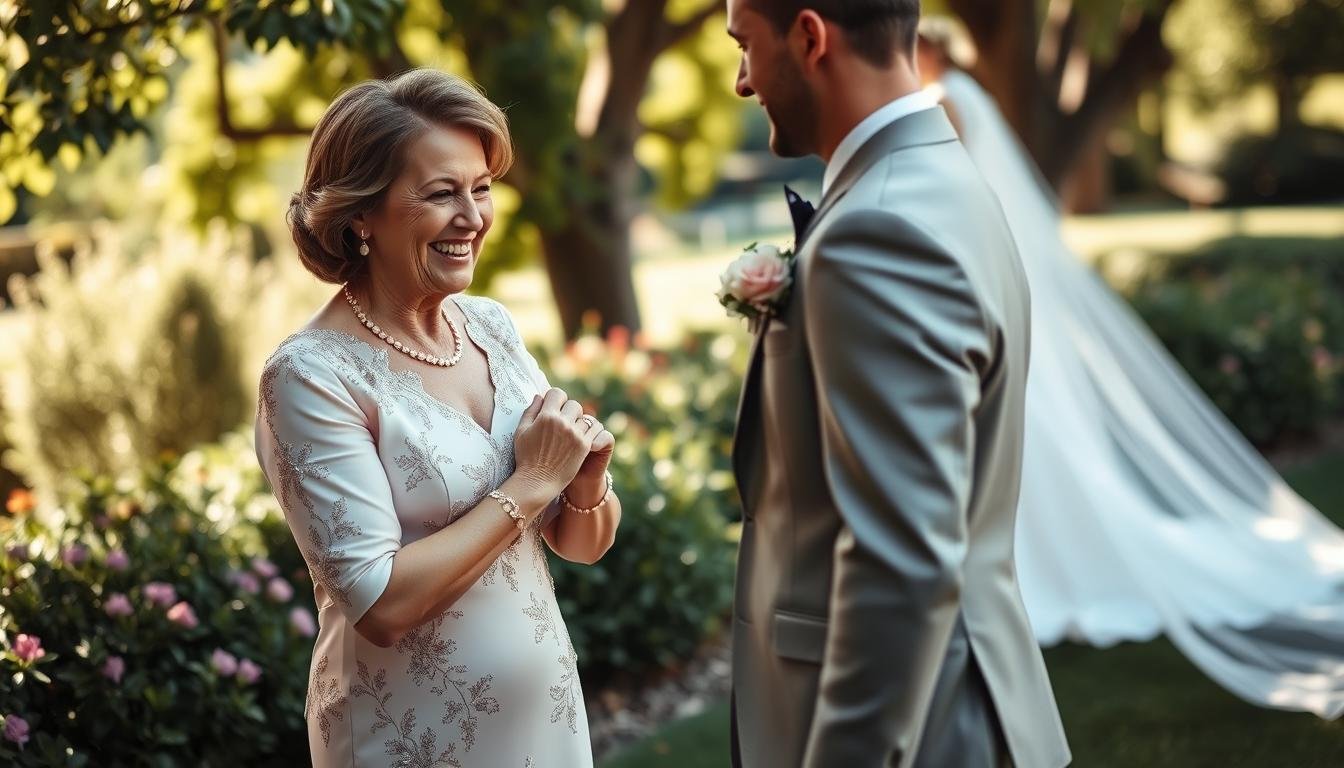Picture this: Laura’s son just got engaged, and she’s over the moon. But as she scrolls through Pinterest boards and listens to her friends’ wedding stories, she starts to wonder—what exactly am I supposed to do here? Sound familiar? You’re not alone. Many moms find themselves balancing excitement with uncertainty when their child’s big day arrives.
Wedding planner Kara Levenbrook puts it best: “The mother of the groom’s role is like a backstage crew member—essential, but never stealing the spotlight.” While the spotlight often shines on the bride’s family, your support matters just as much. Summer Newman, a seasoned wedding coordinator, notes that clarity early on helps everyone stay stress-free. Are you handling the rehearsal dinner? Coordinating family photos? Knowing your lane keeps the planning smooth.
This guide isn’t about strict rules—it’s about creating harmony. We’ll walk through everything from outfit choices to navigating tricky conversations with the couple. Think of it as your playbook for celebrating your child while honoring their vision. Let’s make this journey joyful, not overwhelming!
Key Takeaways
- Clarify your role early to avoid planning conflicts
- Focus on supporting the couple’s vision, not imposing your own
- Coordinate closely with the bride’s family for seamless events
- Balance involvement with respecting boundaries
- Use style choices to complement the wedding theme
Understanding the Role of the Groom’s Mother
What’s the secret sauce to being an amazing groom’s mom? It starts with knowing your unique lane. While the bride’s family often takes center stage, your role is more like a trusted co-pilot—offering support without grabbing the wheel.
Who Does What?
Wedding planner Kara Levenbrook shares a golden rule: “The groom’s mom focuses on logistics, while the bride’s mom handles aesthetics.” This split keeps things smooth. Your main jobs? Nailing the rehearsal dinner guest list, coordinating family arrivals, and being the calm voice during last-minute hiccups.
| Groom’s Mother | Bride’s Mother |
|---|---|
| Hosts rehearsal dinner | Coordinates ceremony decor |
| Manages groom’s family RSVPs | Oversees bridal party prep |
| Shares family heirlooms quietly | Leads dress shopping events |

Crafting Heartfelt Moments
Want to create magic? Think subtle. Offer to compile childhood photos for the slideshow or suggest a father-son dance surprise. One mom I worked with secretly gathered letters from the groom’s friends—then bound them into a book the couple still treasures.
Pro tip: Text the bride’s mom first before suggesting ideas. A quick “Would it help if I…?” builds bridges instead of burning them. Remember—your superpower is making the day easier, not perfect.
Mother of the Groom Etiquette and Traditions
Your son’s wedding marks a milestone where your support shines through thoughtful actions rather than grand gestures. Seasoned planner Marissa Cohen notes: “The most cherished contributions often happen behind the scenes—like ensuring every RSVP gets a personal follow-up call.“

Strategic Support Without Overstepping
Focus on tasks that play to your strengths. Managing the groom’s family guest list? Perfect. Offering to track RSVPs for out-of-town relatives? Gold. One mom I know created a color-coded spreadsheet that became the couple’s planning bible—without overshadowing their choices.
When traditions matter, suggest don’t insist. Maybe your family lights a unity candle during ceremonies. Float the idea gently: “Would you two consider including Papa’s vintage menorah in the reception décor?” It’s about weaving heritage into their story, not rewriting chapters.
Memory-Making Through Collaboration
Tag along for cake tastings or suit fittings—these moments become core memories. Last summer, a groom’s mother surprised everyone by secretly arranging his childhood photos as table centerpieces. The key? She ran the idea by the bride’s mom first.
Cohen puts it bluntly: “Your role isn’t to plan—it’s to pave the way.“ Whether coordinating seating charts or sharing family recipes with caterers, your quiet groundwork lets the couple’s vision take center stage.
Managing Family Dynamics and Communication
Let’s face it—weddings can turn even the closest families into a tangle of opinions. The key? Nail the balance between enthusiasm and respect early. Seasoned mediator Dr. Ellen Torres puts it bluntly: “Unspoken expectations are relationship grenades—always defuse them before the pin gets pulled.”

Setting Healthy Boundaries
Boundaries aren’t walls—they’re guardrails. When Janice’s son got engaged, she texted the bride’s mom: “I’d love to help with the rehearsal dinner—should I check with you before reaching out to vendors?” That simple question prevented three potential conflicts.
Stick to your lane like it’s GPS-guided. If the couple wants a child-free reception? Back that play with relatives. Managing your own family’s RSVPs? Perfect. Trying to redesign the centerpieces? Hard stop.
Effective Conversations with In-Laws
Start with curiosity, not demands. Try: “What parts of the planning process feel most stressful? Maybe I can handle X so you’ve got bandwidth for Y.” One mom I know bonded with her new in-laws by co-managing transportation for elderly guests.
Timing matters too. Avoid wedding chats during holidays or big family events. Dr. Torres suggests: “Schedule a coffee date specifically for planning talks—it keeps emotions from hijacking casual moments.” Remember—you’re building bridges, not drafting treaties.
Navigating Key Wedding Events and Responsibilities
Ever wondered how to make wedding logistics feel less like a puzzle? Your behind-the-scenes magic keeps the gears turning smoothly. Let’s break down your playbook for two critical tasks that’ll make everyone’s experience shine.

Coordinating Rehearsal Dinner and Guest Lists
Start by locking down the rehearsal dinner details early. One mom I worked with created a shared Google Sheet with three tabs: confirmed invites, dietary notes, and vendor contacts. Pro tip: Text the bride’s parents first—“Would 6 PM work for your side of the family?” avoids timing clashes.
Manage your son’s guest list like a pro:
- Track RSVPs weekly using automated reminders
- Assign colored dots on seating charts for dietary needs
- Keep a “maybe” list for last-minute additions
Assisting with RSVP and Seating Arrangements
Seating charts don’t have to be stressful. Use sticky notes on a poster board to visualize groupings. Place divorced parents on separate sides but equidistant from the couple. Wedding planner Mia Torres suggests: “Cluster guests by connection—college friends here, soccer buddies there—it sparks natural conversations.”
When finalizing arrangements:
- Place elderly relatives near exits for easy access
- Mix outgoing and shy guests at tables
- Flag potential conflict pairs for vendors
Clear vendor communication saves everyone time. Email the venue a week before with notes like “Aunt Linda needs a ramp access seat”. Your organized approach turns chaos into celebration—leaving the couple free to savor their big day.
Mother of the Groom Dress and Style Etiquette
Your son’s wedding day calls for an outfit that celebrates joy without stealing the show. Think of your look as the perfect supporting character—elegant enough to honor the occasion, subtle enough to let the couple shine. As stylist Lena Carter advises: “Your dress should whisper ‘I’m here for you,’ not scream ‘Look at me!’”

Choosing the Right Outfit for the Occasion
Venue matters. A beach ceremony? Flow chiffon works. Black-tie ballroom? Consider a luxe cocktail dress. One mom nailed it by matching her hemline to the venue—tea-length for a garden wedding, floor-length for a cathedral.
Ask the couple about formality levels. A quick “Would navy or champagne fit better with your palette?” shows you’re team player. Avoid white, ivory, or anything resembling the bridal party’s hues.
Coordinating with the Bride’s Family
Text the bride’s mom first. “I’m eyeing slate blue—does that complement your outfit?” solves 90% of coordination issues. Most families aim for complementary tones rather than matchy-matchy looks.
Modern twist? Try these combos:
| Bride’s Family Colors | Groom’s Family Pairings |
|---|---|
| Dusty rose | Mauve or silver |
| Emerald green | Sage or gold |
| Navy blue | Periwinkle or champagne |
Remember—comfort fuels confidence. If you’re tugging at straps or limping in heels, you won’t enjoy the big day. Carter’s rule? “Wear it around your house for an hour before deciding.” Your radiant smile will outshine any outfit!

Final Thoughts
Ready to shine in your role while keeping the focus where it belongs? As you navigate your son’s big day, remember—your supportive presence matters more than perfect execution. Whether coordinating outfits or managing guest lists, success lies in balancing enthusiasm with thoughtful restraint.
Start by aligning your efforts with the couple’s vision. A quick chat about color schemes or ceremony flow shows you’re invested in their dream wedding. Wedding planner Kara Levenbrook’s advice rings true: “Your greatest gift isn’t perfection—it’s presence.”
Clear communication builds bridges. Text the bride’s parents before suggesting ideas—“Would it help if I handled transportation logistics?” keeps everyone rowing in the same direction. And when emotions run high? Lean into shared excitement rather than opinions.
From selecting understated elegance in your attire to discreetly organizing family photos, your role weaves tradition into new memories. That father-son dance you helped plan? It’ll echo through family stories for decades.
Ultimately, this journey isn’t about checklists—it’s about crafting meaningful connections. Trust your instincts, honor boundaries, and savor every joyful moment. After all, the best celebrations grow from relationships nurtured with care.
We recommend reading How do I handle family conflicts during wedding planning? where we provide you with easy, stress-free solutions that will help you avoiding this un-necessary stress.
FAQ
What’s the groom’s mother’s main role during wedding planning?
Your primary focus is supporting the couple’s vision while offering help where needed—like hosting the rehearsal dinner, assisting with guest lists, or sharing family traditions. Stay attuned to their preferences, and let the bride’s family take the lead on major decisions.
How can I coordinate outfits with the bride’s mom without clashing?
Start by asking the couple about the wedding’s color palette or theme. A quick chat with the bride’s mother—even via text—can help align styles. Opt for complementary shades rather than matching exactly, and avoid white or ivory to let the bride shine.
Should I give a speech at the reception?
A> While it’s not required, many moms choose to toast during the rehearsal dinner instead. If you’d like to speak at the reception, check with the couple first. Keep it brief, heartfelt, and inclusive of both families.
How do I handle disagreements with the bride’s family?
A> Prioritize open, kind communication. If tensions arise, focus on shared goals—like creating a joyful day for the couple. If needed, suggest a neutral mediator (like the wedding planner) to help navigate sticky situations.
What’s expected for the rehearsal dinner budget?
A> Traditionally, the groom’s family covers this event, but costs vary widely. Discuss expectations early with the couple—are they imagining a backyard BBQ or a formal sit-down? Set a comfortable budget upfront and stick to it.
Can I invite additional guests beyond the main wedding list?
A> Unless you’re hosting (and paying for) the entire wedding, avoid adding extras without checking. If you’re handling the rehearsal dinner, you’ll have more flexibility for your own invites there.
How involved should I be in choosing the venue or decor?
A> Unless the couple asks for input, take a supportive backseat role. Offer opinions only when requested, and focus on tasks they delegate to you—like researching bakeries or addressing envelopes.








